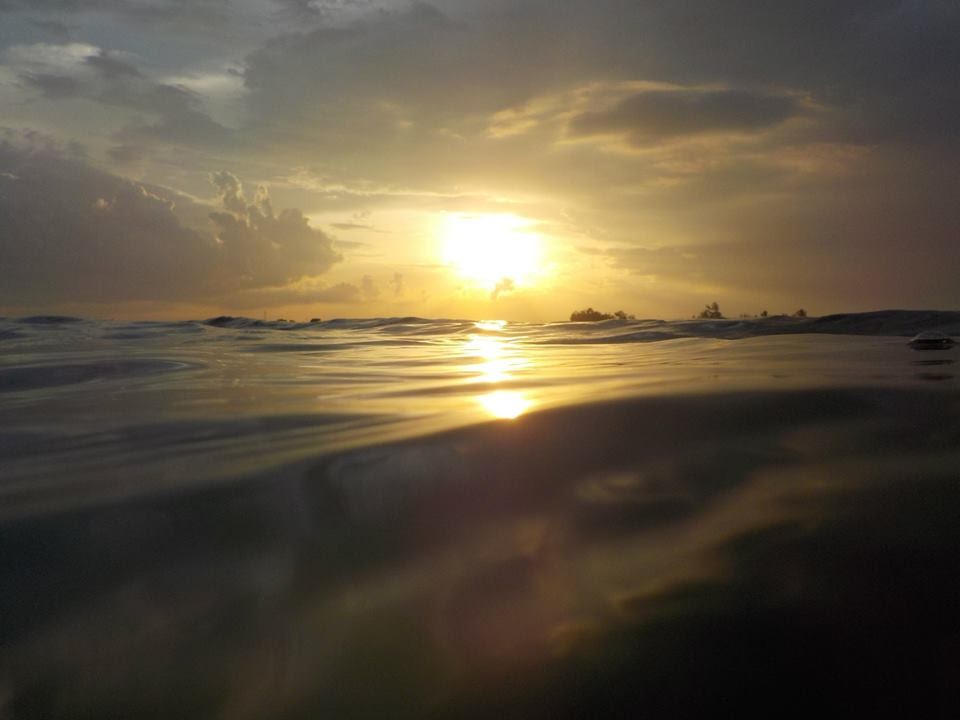OES Field Projects: Environmental Science
Environmental science is the study of the interactions between organisms and their environment and ecosystem health. It uses a mixture of chemistry, biology and physics to solve environmental issues. Environmental science as a major is a lot of fun because it’s very versatile — you can work in the field, in the office; you have your choice of subdisciplines — chemistry, biology, physics; you can work in either marine or terrestrial ecosystems, etc. Many students here at Florida Tech work out of the Indian River Lagoon.
One field projects student who worked in this area was Kate Beckett, who also took the above photo while out collecting fish for her project. Beckett chose to work with Professor Trefry (a non-field projects professor). Her project was about biomagnification of mercury in estuarine organisms in the Indian River Lagoon. After graduation, Beckett plans to do her master’s degree in chemical oceanography with Professor Trefry.
Another student was Alex Nickerson, a meteorology student who decided to do his primary project on determining the presence of synthetic fibers in the Indian River Lagoon. Nickerson also plans to continue his studies in graduate school, majoring in either meteorology or physical oceanography. I asked Beckett and Nickerson a few questions about their field projects experience.
What was your favorite part of field projects?
Kate: My favorite part was the cruise. It really taught me a lot about how scientists operate on a vessel in the only way one can properly learn.
Alex: My favorite part of field projects was actually the cruise. It was the perfect mix of fun, adventure and education all encapsulated in three days, but they were three of the best days of my life.

What did you learn from field projects?
Kate: Field projects provided hands-on learning that is not offered in any other class. For example, how to measure mercury concentrations in aquatic organisms. It helped provoke my interest in chemical oceanography and inspired me to continue on to my master’s.
Alex: Field projects taught me how to refine and put into use scientific principles and experiments to create a strong project with minimal error. While I had done research before field projects, I had never done such involved hands-on activity. It was an experience I can never trade for any other.
Kate, your project involved a lot of filleting small fish and dissolving muscle tissue in order to be able to determine the concentrations of mercury in the fish. How did you respond to accusations that you are a fish murderer?
Kate: Sometimes, discovery requires some sort of sacrifice, whether it be money, time or dissecting organisms. All fish were humanely killed and left-over fillet material was recycled. My project looked at the lower trophic organisms to better understand the concentrations of mercury in larger marine organisms, such as dolphins. I hope that one day lower trophic concentrations can be used to accurately predict those of upper trophic levels, so only lower trophic organisms would have to be measured.
Very diplomatic response, Kate. So Alex, you took a risk on your project idea and you spent a lot of tedious hours staring through the lens of a microscope, examining water samples and plucking out tiny fibers. How did you handle finding out your hypothesis was not supported by your data? Some scientists take it personally but you kept to your project and you presented beautifully at the symposium.
Alex: Sorting through the fibers was indeed a pretty tedious project. Fortunately, the samples were small enough that I could sort through an entire dish in about 30 minutes. That being said, there were still over 20 different dishes I had to sort through and remove fibers from. Professor Johnson and I were sincerely hoping that we had plastic in the dish. If it had been plastic, it would have been a major discovery with major implications for me, Professor Johnson and Professor Hunsucker, and possibly could have led me down a new career path. So, it was indeed a major disappointment to find out that I was pretty much staring at jeans fibers for 2 months. Nevertheless, there was an upside: I had indeed found anthropogenic fibers, just not the ones I had been hoping for. Through it all, I still had a story to tell and a project to be proud of.
Kate and Alex were only two of the five students who had primary projects related to environmental science. A full list of students and their projects can be found below. Their presentation videos are linked to their project titles, so if anyone’s project sounds interesting to you, check it out!
2014 DMES Environmental Science Field Projects:
Kate Beckett: Biomagnification of Mercury in the Indian River Lagoon
Tori Benjamin: Potential Use of Drift Algae as a Fertilizer for Terrestrial Plants
Jean Hirschfeld: Short Term Changes in Seagrass Meadows in the Northern Indian River Lagoon
Alex Nickerson: Drifting Anthropogenic Fibers in the Indian River Lagoon
Ashley Philbeck: Nutrient Fluxes from Turkey and Crane Creeks to the Indian River Lagoon, Florida





